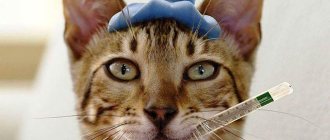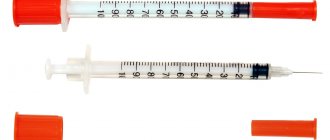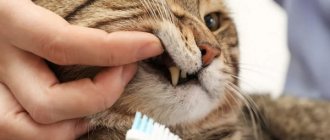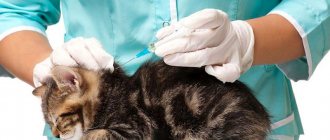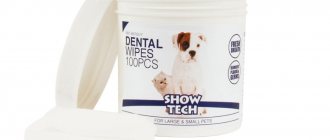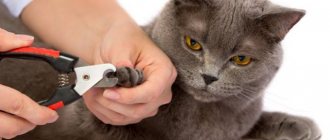Symptoms of fever in a cat
Common symptoms of fever in a cat that warrant taking the animal's temperature are:
- lethargy;
- refusal of food;
- hot nose or ears;
- rapid breathing;
- cardiopalmus;
- diarrhea;
- vomit.
Symptoms of low body temperature are:
- severe lethargy
- food refusal
- shiver;
- cold parts of the body, such as the pads of the feet, signs of chills;
- convulsions.
Symptoms of hypothermia
What are the symptoms of hypothermia in cats? They largely depend on how far the pathological process has progressed. In most cases, the following clinical signs can be observed:
- Severe and uncontrollable shaking . But it only happens in mild cases of hypothermia. So if you notice that your pet is literally “shaking” from the cold, you can consider him lucky.
- If you put your hand on the skin on a cat's belly, you can feel the cold coming from it. Since the abdomen and groin area are usually the warmest under normal conditions, this simple test is very revealing.
- Apathy , the cat tries to hide in the farthest corner and does not come out, even to eat.
- Lethargy.
- Drowsiness.
- Decreased rectal temperature . This is a very dangerous symptom, since under normal conditions the temperature in the rectum is approximately 0.5-1°C higher than when measured in the ear or mouth. This is observed only in severe forms of hypothermia, in which case it is strongly recommended to immediately show the animal to an experienced veterinarian.
- Slow and shallow breathing.
- Slow heartbeat (bradycardia).
- Inappropriate behavior.
- Coma.
- Death.
How to bring down or increase the temperature
If a cat's body temperature increases or decreases, in order to temporarily alleviate its physiological condition, it is possible, depending on the situation, to lower or increase the temperature.
Attention! There is no treatment for temperature as such; temperature is only a symptom indicating the presence of pathology in the animal’s body.
In order to bring down the temperature, you need to wrap the cat in a damp, cold towel, give it a cold drink (slightly below room temperature), put it in a cool place without drafts, but under no circumstances on a concrete floor or ground. If the temperature rises due to illness, it is necessary to urgently begin treatment for the disease and take a course of IV drips to reduce the temperature.
A pet with hyperthermia should never be given fever-reducing medications intended for humans.
First aid for fever is to wrap the animal in a cold, wet towel and take it to the clinic. Drinking water must be available at all times.
To increase the temperature, the cat must be placed on a warm heating pad, and bottles of warm water wrapped in a rag should be placed next to it (to prevent burns). Give a warm drink. If a decrease in temperature occurs against the background of a disease, immediately begin treatment and raise the temperature in a veterinary clinic.
First aid for a low temperature is to put the cat on a heating pad, give him warm water to drink and take him to the clinic.
What to do if the kitten does not eat.
If a kitten does not eat, this is always a reason to take a very careful look at its condition. If the lack of appetite in kittens is the first sign of an acute viral infection, then the count is not in days, but in hours. And the sooner you seek help from a veterinarian, the better the baby’s chances. Unfortunately, kittens are very susceptible to infections and they can occur at lightning speed, with high mortality, even with proper treatment. Especially if the kitten is weakened by other factors:
- parasites
- malnutrition
- hypothermia
- lack of vaccination
- stress.
The younger the kitten, the higher the risk of a bad outcome, since the immune system is not yet ready to fully fight viruses.
But let's take things in order. The first thing to exclude is not diseases, but the influence of third-party factors:
Type of feed.
Kittens' eating habits are formed in the first 3-4 months after birth. In many ways, their taste preferences in life depend on what is offered to them during this period. The consistency, texture of food (dry food/pates/pieces, etc.), its smell, and temperature are very important. If you are adopting a kitten, find out exactly what the previous owners or breeders fed it. And for the first time, feed in the same way. And when the kitten gets used to its new home, then you can gradually switch it to the food you want.
Avoid sudden changes in food, do not introduce several new products at the same time.
- The kitten has already eaten something without your knowledge.
- Check if the kitten's bowl is located in a convenient place. It should not be located next to the cat litter box, nor should it be in the walkway. If there is a dog in the house, it is better to feed the kitten on a hill so that the dog does not disturb it. If there are several cats in the house, then at first you need to keep an eye on it so that the older cats do not intercept the baby’s food.
- Stress after moving to a new home, traveling in a car or transport, going to the veterinarian, guests, active children - any factor can be the cause of a kitten’s poor appetite.
The most common diseases that cause a kitten to refuse to eat:
- First of all, these are parasitic diseases. 90% of kittens have worms and/or protozoa, even if they come from a “good” family and their mother was treated for worms. There is no doubt about kittens picked up on the street. The presence of helminths will also be indicated by the following signs:
- increase in abdominal volume
- bloating
- flatulence
- soft or loose stools, mucus or blood in the stool
- underweight kitten
- absence or, on the contrary, increased appetite.
If the kitten is very exhausted or has other parasites, it is best to treat it for worms under the supervision of a doctor. Since the massive death of parasites can worsen the baby’s condition.
- Viral infections. As described above, this is a very dangerous situation for the health and life of the kitten. Most often in small kittens, calicivirus and herpesvirus infections occur (mainly affecting the respiratory organs - nose, trachea, bronchi, lungs, and eyes), panleukopenia (affects the gastrointestinal tract, destroys the immune system). All of these diseases are life-threatening. And they require prompt intervention from a specialist.
- Diseases of the gastrointestinal tract. At a young age, in addition to inflammation of the stomach and intestines of a parasitic and infectious nature, foreign bodies and poisoning are more common when the kitten has eaten something inedible and harmful (leaves of poisonous plants, chocolate and other “goodies”)
For kittens, the recommendation not to self-medicate is doubly relevant. And if the condition of your four-legged baby causes concern, seek professional help as soon as possible. This could save his life.
CALL, take care of your pet's health!
VET CLINIC DOG AND CAT
Kharkov (M. 23 August) st.
Novoprudnaya, 9B OPENING MODE: ROUND THE CLOCK
Call center:
☏ (057) 751-32-42 ☏ (063) 722-88-48
☏ (066) 875-31-13 ☏ (096) 880-89-11 viber
Body temperature after sterilization or castration
In the first hours after sterilization and castration, male cats may experience a decrease in body temperature, most often this occurs after sterilization.
After sterilization or castration, the animal must be returned from the veterinary clinic with a temperature of 37.8-39 degrees.
If, after being discharged from the veterinary clinic, the operated pet has a sharp drop or rise in temperature, this is a reason to immediately contact the veterinary clinic. Thus, various postoperative complications may occur.
Heatstroke
Kittens and adult animals do not tolerate prolonged stays in rooms with poor ventilation and elevated air temperatures. Heatstroke is sometimes experienced by owners who bring their pets to exhibitions. Such a violation can be caused by a trip to tropical countries with a hot climate. An animal can get heatstroke in a car if it stays in a closed cabin in the sun for a long time. It can cause a temperature rise of up to 41 degrees.
The following symptoms appear during heatstroke:
- labored breathing,
- increased heart rate,
- fainting state,
- vomit.
The cat has a blank look, lies on the floor, and is inactive.
If possible, the pet should be immediately immersed in cold water to lower the temperature. But if such a procedure cannot be carried out, then it is necessary to provide access to cool air for the cat. You can at least fan her, wash her face with water, apply ice to her head, and give her a massage. After removing the main signs, the animal must be taken to a veterinary hospital for examination.
If your cat has to be transported in a car on long trains, you should have an adequate supply of drinking water with you. When an animal stays in the cabin for a long time, it is necessary to provide air ventilation.
How to measure a cat's temperature
There are two ways to measure a cat's temperature: rectally or through the ear canal.
The temperature is measured rectally with a regular mercury or electronic thermometer, having previously lubricated it with liniment.
Disadvantages of using a mercury thermometer:
- duration of the measurement procedure (7 - 10 minutes) - due to stress, the animal’s temperature may increase, which may distort the objectivity of the obtained indicators;
- fragility of a mercury thermometer - an animal, especially an aggressive one, can break free during the thermometry process, break the thermometer and injure itself.
Taking this into account, in most cases, veterinarians use electronic thermometers specially designed for this method of thermometry to measure rectal temperature.
To measure a cat's temperature rectally, use a special bag - a clamp, or take measurements as follows:
- During the thermometry process, it is advisable to keep the animal together;
- the pet is fixed under the arm, with all four paws placed on a hard surface;
- the thermometer is smoothly inserted rectally to a depth of no more than 2 cm, strictly at an angle of 90 degrees;
- measurement duration is 2-3 minutes with an electronic thermometer, or 7-10 minutes with a mercury thermometer.
You can also measure a cat’s temperature through the ear canal using an infrared non-contact thermometer, but due to the relatively high cost of this device, this method of thermometry is not yet very widespread.
Antipyretic for cats
If our advice did not help you, and you do not know how to lower your cat’s temperature before the veterinarian arrives, call the doctor, maybe he will allow you to use antipyretics before his visit. The main rule is to never give human medications to cats.
A cat's temperature can be reduced with the following medications:
- Tsefekon - candles.
- Papaverine and diphenhydramine - injections.
- Echinacea – tincture.
- Meloxicam - tablets.
All these drugs, as well as others, can be given only on the recommendations of the treating specialist.
What is hypothermia?
A decrease in body temperature in an animal (hypothermia) is a condition of the body. The temperature drops below what is necessary to maintain normal body functioning and metabolism.
Body temperature is regulated by the hypothalamus, which controls thermoregulation processes: chemical (a set of physiological processes that ensure metabolism and heat formation in the animal’s body under the influence of various temperatures and other factors in the external environment) and physical (a set of physiological processes that regulate the release of heat from the body, which provides constant body temperature of the animal).

